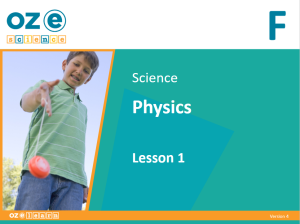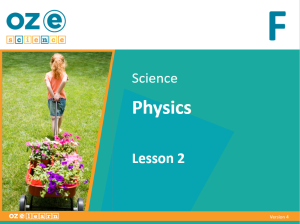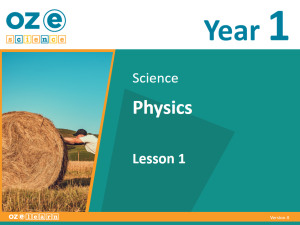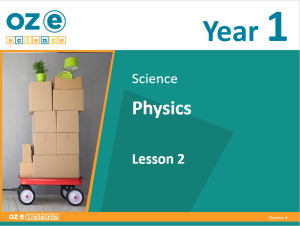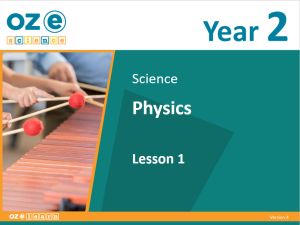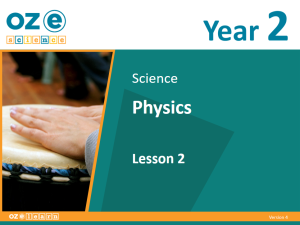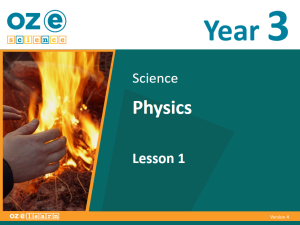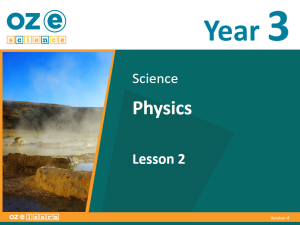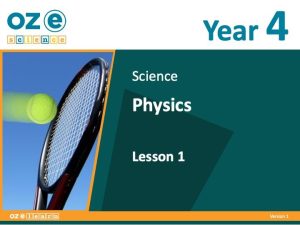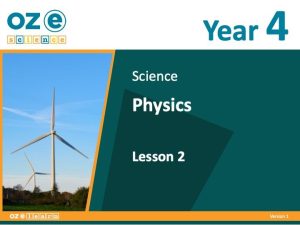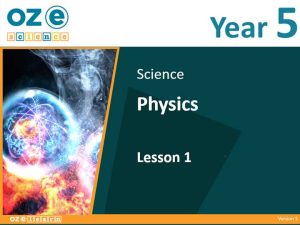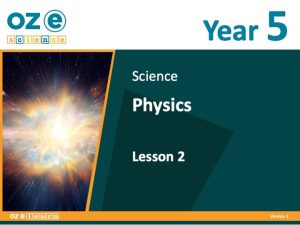Oz-e-science
Physics Years F–6
Oz-e-science Physics units align to the Australian Curriculum Content Descriptions.
Free Starter Lessons
Year Overview
Australian Curriculum Content Descriptions
Overview
Physics Foundation Year is the study of what things are made of, how they move and how they get energy. It aligns to the Australian Curriculum Science Understanding:
- Describe how objects move and how factors including their size, shape or material influence their movement (AC9SFU02).
Learning Objectives
In lessons 1 to 9, students learn about:
- why objects move because of a force
- forces that make objects move or change direction
- how different shapes of objects affect their movement
- how the weight of an object affects how it moves
- how the size of an object affects its movement
- how the material that objects are made of affects their movement
- how force can change the direction of an object
- how force can change the direction of an object
- the concept of movement.
Success Criteria
- Explain why objects move because of a force.
- Demonstrate how a soccer ball moves because of a force.
- Identify forces that make objects move or change direction.
- Identify all the ways a human body can exert force.
- Explain how different shapes of objects affect their movement.
- Investigate how different shapes of objects affect their movement.
- Explain how the weight of an object affects how it moves.
- Observe how the weight of an object affects how it moves.
- Explain how the size of an object affects its movement.
- Observe how the size of an object affects how it moves.
- By the end of this lesson, students will be able to:
- Describe how materials affect the movement of objects.
- Understand how the material of objects affects their movement.
- Explain how force can change the direction of an object.
- Understand how force can change the direction of an object.
- Explain how objects made of different materials and weight spin differently.
- Understand how objects made of different materials and weight spin differently.
- Describe the concept of movement.
- Communicate their understanding of movement concepts.
Assessment
End-of-Unit Assessment
The last lesson is the end-of-unit assessment which has a variety of question formats (for example, label the diagram, circle the correct answer) to assess student mastery of content from the unit. The end-of-unit assessment is in the Teaching Guide. Teachers copy the assessment and distribute to students at testing time.
Australian Curriculum Content Descriptions
Overview
Physics Year 1 is the study of what things are made of, how they move, and how they get energy. It aligns to the Australian Curriculum Science Understanding:
- Describe pushes and pulls in terms of strength and direction and predict the effect of these forces on objects’ motion and shape (AC9S1U03).
Learning Objectives
In lessons 1 to 9, students learn about:
- examples of the force of pushing
- examples of the force of pulling
- the position of the push force, the object, and the direction of the force
- the position of the pull force, the object, and the direction of the force
- how push forces can change the shape of objects
- how pull forces can change the shape of objects
- examples of push versus push forces
- examples of pull versus pull forces
- examples of push and pull forces in sport.
Success Criteria
- Identify pushing actions.
- Create and sort examples of objects being pushed.
- Identify pulling actions.
- Create and sort examples of objects being pulled.
- Identify the two things about the push force: position and direction of force.
- Identify the position of the push force and the object and their direction.
- Identify the position of the pull force and the object and their direction.
- Identify how objects change shape and direction when being pushed.
- Identify when push forces are more or less likely to change the shape of an object and their direction.
- Identify how objects change shape and direction when being pulled.
- Identify when pull forces are more or less likely to change the shape of an object and their direction.
- Identify examples of push versus push forces.
- Identify what happens when one push force is less than, equal to and greater than another push force.
- Identify examples of pull versus pull forces.
- Identify when an object will move in the direction of the strongest pull force.
- Identify examples of push and pull forces in sports.
- Demonstrate examples of push and pull forces in sports.
Assessment
End-of-Unit Assessment
The last lesson is the End-of-Unit Assessment, which has a variety of question formats (e.g., label the diagram, circle the correct answer) to assess student mastery of content from the unit. The End-of-Unit Assessment is in the Teaching Guide. Teachers copy the assessment and distribute to students at testing time.
Australian Curriculum Content Descriptions
Overview
Physics Year 2 is the study of what things are made of, how they move, and how they get energy. It aligns to the Australian Curriculum Science Understanding:
- Explore different actions to make sounds and how to make a variety of sounds, and recognise that sound energy causes objects to vibrate (AC9S2U02).
Learning Objectives
In lessons 1 to 9, students learn about:
- how force applied to materials creates sound
- how movement (kinetic energy) converts into sound energy
- that vibrations of materials create sound waves
- how sound waves travel through different mediums
- how we sense sound through hearing and feeling
- sound intensity and its measurement
- the sound of music
- how sound is sometimes absorbed and sometimes reflected by certain materials
- the speed of sound.
Success Criteria
- Explain how force applied to materials creates sound.
- Show how force on materials makes sound.
- Explain how movement (kinetic energy) converts into sound energy.
- Observe how movement (kinetic energy) converts into sound energy.
- Describe how different materials vibrate to produce sound.
- Observe how different materials vibrate to produce sound.
- Describe how sound waves travel through different mediums.
- Investigate how sound waves travel through solids.
- Explain that humans sense sound through hearing and feeling.
- Investigate sensing sound through hearing and touch.
- Explain sound intensity and its measurement.
- Investigate sound intensity and its measurement.
- Explain the difference between noise and music.
- Identify pitch variations.
- Explain how sound is sometimes absorbed or reflected.
- Explain how sound is sometimes absorbed or reflected.
- Recall what we have learned about sound in this Unit.
Assessment
End-of-Unit Assessment
The last lesson is the end-of-unit assessment which has a variety of question formats (e.g. label the diagram, circle the correct answer) to assess student mastery of content from the unit. The end-of-unit assessment is in the Teaching Guide. Teachers copy the assessment and distribute to students at testing time.
Australian Curriculum Content Descriptions
Overview
Physics Year 3 is the study of what things are made of, how they move and how they get energy. It aligns to the Australian Curriculum Science Understanding:
- Identify sources of heat energy and examine how temperature changes when heat energy is transferred from one object to another (AC9S3U03).
Learning Objectives
In lessons 1 to 9, students learn about:
- how heat is a form of energy
- sources of heat energy
- how heat can transfer from one object to another through direct contact
- how heat can transfer from one object to another at a distance
- the concept of insulation
- temperature as the measure of heat energy
- human body temperature
- how heat energy always moves from hot to cold objects
- the transfer of solar energy to heat energy.
Success Criteria
- Explain that heat is a form of energy.
- Sort various forms of heat energy.
- Identify sources of heat energy.
- Sort sources of heat energy.
- Explain that heat can transfer through direct contact.
- Investigate heat transfer from one object to another through direct contact.
- Describe how heat energy can be transferred to another object at a distance.
- Investigate heat transfer from one object to another at a distance.
- Explain how insulation can keep things warm or cold.
- Investigate which materials will make the best insulator.
- Explain temperature and how it is measured.
- Measure the temperature of different objects using a thermometer.
- Identify the average human body temperature.
- Sort examples of temperature to understand how heat and body temperature relate to each other.
- Explain that heat energy always moves from hot to cold.
- Observe how heat transfers from a warmer object to a colder object.
- Explain the transfer of solar energy to heat energy.
Assessment
End-of-Unit Assessment
The last lesson is the end-of-unit assessment which has a variety of question formats (e.g. label the diagram, circle the correct answer) to assess student mastery of content from the unit. The end-of-unit assessment is in the Teaching Guide. Teachers copy the assessment and distribute to students at testing time.
Australian Curriculum Content Descriptions
Overview
Physics Year 4 is the study of what things are made of, how they move, and how they get energy. It aligns to the Australian Curriculum Science Understanding:
- Forces can be exerted by one object on another through direct contact or from a distance (ACSSU076).
Learning Objectives
In lessons 1 to 9, students learn about:
- what a force is and identify some common examples of forces in our everyday lives
- identifying different types of forces and explain the difference between contact and noncontact forces
- describing the ways forces can push and pull objects, causing them to move or stop moving
- how forces can resist objects when they are moving
- how forces can repel two objects away from each other or attract two objects closer to each other
- the force of gravity and how it affects objects of different sizes and shapes
- Sir Isaac Newton and how his law of forces can explain the size and direction of forces
- the Scientific Method to investigate Newton’s Laws
- preparing a report about our findings.
Success Criteria
- Describe what a force is.
- Identify some common examples of forces.
- Explain what happens to an object when a force acts on it.
- Identify contact and non-contact forces.
- Explain what happens to objects when contact and non-contact forces act on them.
- Identify the forces used in pushing and pulling objects.
- Explain what normal and applied forces are.
- Investigate motion by experimenting with pushing and pulling objects.
- Identify the forces that can resist an object’s movement.
- Explain what friction and resistance are.
- Investigate friction by experimenting with objects moving.
- Identify the forces that can attract and repel objects.
- Explain what magnetic fields are.
- Investigate attracting and repelling by experimenting with magnets.
- Explain what gravity is.
- Describe how gravity works.
- Investigate gravity by experimenting with objects falling.
- Describe Newton’s Laws.
- Compare the size and direction of forces.
- Investigate what happens to an object experiencing more than one force.
- Identify the steps in the Scientific Method.
- Experiment with Newton’s laws using cars on a ramp.
- Measure the effect that the steepness of a ramp has on forces.
Assessment
Progress Tests
Progress tests are conducted after every second lesson, allowing teachers to monitor student understanding of the concepts taught over the past two lessons and to identify where reteaching is needed. The Teaching Guide contains the testing questions, and the Student Workbook has a section where students write their answers and score themselves.
Structured Research Activity
The Structured Research Activity (SRA) for this unit is: Students to investigate Newton’s laws school experiment. The SRA takes place over two lessons so students can apply the Science Understanding and Science Inquiry Skills covered in the unit. Teachers use the Guide to Making Judgements, which is included in the Teaching Guide, to mark the SRA.
End-of-Unit Assessment
The last lesson is the end-of-unit assessment which has a variety of question formats (e.g. label the diagram, circle the correct answer) to assess student mastery of content from the unit.
Australian Curriculum Content Descriptions
Overview
Physics Year 5 is the study of how objects can have an effect on other objects even when they are not in contact with them. It aligns to the Australian Curriculum Science Understanding:
- Light from a source forms shadows and can be absorbed, reflected and refracted (ACSSU080).
Learning Objectives
In lessons 1 to 9, students learn about:
- what a photon is, how they are created in the Sun’s core and how long they take to travel to the surface
- how fast photons can move through space
- how we can see light
- how light can only pass through some materials and not others
- how a single ray of light can be bent and split into many different colours and directions
- how colour is caused by light
- how light is unique because it behaves both like a wave and also like a particle
- applying the Scientific Method to prove that light can move like a particle
- evaluating and communicate your findings to the class.
Success Criteria
- Describe what a photon is.
- Explain how photons are created.
- Explain how photons make their way to the Sun’s surface.
- ͏Describe the speed of light.
- Explain how the light we see today can be very old.
- Compare how long it takes light to reach us from different objects.
- ͏Describe how we see light.
- Explain what a reflection is.
- Compare how light reflects from different surfaces.
- Describe the terms transparent, opaque, translucent and absorption.
- Explain how density impacts the absorption of light.
- Compare how light is absorbed by different materials.
- ͏Describe what happens to the path of light when it hits different objects.
- Explain what refraction is.
- ͏Compare how light bends and splits using different materials.
- ͏Describe how colour is made from light.
- Explain what the light spectrum is.
- Observe how light can be used to create colour.
- ͏Describe how the colour of light changes when it moves towards us or away from us.
- Explain the Doppler effect.
- ͏Observe the Doppler effect using sound.
- ͏Describe how objects are moved because of gravity.
- Explain how light can be bent by very large objects.
- Represent how light bends around a heavy object in space.
- ͏Analyse how scientists first discovered black holes.
- Explain how and why black holes form.
- Represent how a black hole traps light.
- Explain what a laser is.
- Describe how scientists use lasers to map out the universe.
- Represent the mapping of the universe using a small laser.
- ͏Explain what astrophysics is.
- Describe the tools and knowledge used in famous theories about space.
- ͏͏Analyse the famous equation E=mc2.
- Identify the steps in the Scientific Method.
- Experiment using the Scientific Method to explore light.
- Investigate materials to see how much light is let through.
- ͏Explain how waves and particles move.
- Describe how we know light moves like both a wave and a particle.
- ͏͏Analyse the famous light experiment that proves light moves like a particle.
- Create a scientific question.
- Create a hypothesis for an experiment.
- Predict the outcome of an experiment.
- Plan an experiment.
- Measure the patterns made by light to determine if it is moving like a wave or a particle.
- Evaluate the results of an experiment.
- Explain the findings using the wave theory of light.
- Communicate findings to the class.
Assessment
Progress Tests
Progress tests are conducted after every second lesson, allowing teachers to monitor student understanding of the concepts taught over the past two lessons and to identify where reteaching is needed. The Teaching Guide contains the testing questions, and the Student Workbook has a section where students write their answers and score themselves.
Structured Research Activity
The Structured Research Activity (SRA) for this unit is: Students to investigate a light school experiment. The SRA takes place over two lessons so students can apply the Science Understanding and Science Inquiry Skills covered in the unit. Teachers use the Guide to Making Judgements, which is included in the Teaching Guide, to mark the SRA.
End-of-Unit Assessment
The last lesson is the end-of-unit assessment which has a variety of question formats (e.g. label the diagram, circle the correct answer) to assess student mastery of content from the unit.
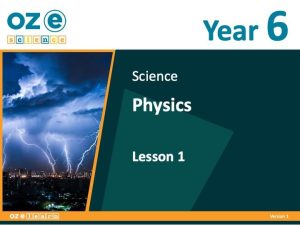
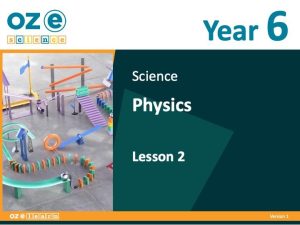
Teaching Resources
Extra Resources
Australian Curriculum Content Descriptions
Overview
Physics Year 6 is the study of how the total amount of energy in the universe is always the same, but energy can be transformed when things change or are made to happen. It aligns to the Australian Curriculum Science Understanding:
- Electrical energy can be transferred and transformed in electrical circuits and can be generated from a range of sources (ACSSU097).
Learning Objectives
In lessons 1 to 9, students learn about:
- different types of energy
- how energy can be transferred from one place to another
- how one kind of energy can be transformed into a different kind of energy
- electrical energy and the renewable and non-renewable sources it comes from
- electric currents and static electricity
- conductors and insulators
- the parts that make up an electrical circuit
- how to conduct an investigation to find out which renewable energy source would be best for your town
- presenting our findings about which renewable energy source would be best for your town.
Success Criteria
- Explain what energy is.
- Describe six different types of energy.
- Observe energy forms in the school.
- Describe examples of how energy is transferred.
- Represent energy transfer using everyday items.
- Describe examples of how energy is transformed.
- Sort examples of energy transfer and transformation in a card game.
- Explain how electrical energy is generated.
- Identify three fossil fuels that are used to generate electrical energy.
- Identify three sources of renewable energy that are transformed to generate electrical energy.
- Explain how electrical energy moves as static electricity.
- Explain how electrical energy moves as an electric current.
- Investigate the effect of static electricity on different objects.
- Explain what makes a material a conductor or an insulator.
- Identify materials as insulators or conductors using a simple circuit.
- Explain what an electrical circuit is.
- Identify a complete circuit.
- Build a simple circuit.
- Form a hypothesis.
- Ask scientific questions.
- Conduct research.
- Analyse and evaluate.
- Explain your results.
- Communicate which renewable energy you would use in your town.
Assessment
Progress Tests
Progress tests are conducted after every second lesson, allowing teachers to monitor student understanding of the concepts taught over the past two lessons and to identify where reteaching is needed. The Teaching Guide contains the testing questions, and the Student Workbook has a section where students write their answers and score themselves.
Structured Research Activity
The Structured Research Activity (SRA) for this unit is: Students to conduct an investigation and present their findings on which renewable energy source would be best for their town. The SRA takes place over two lessons so students can apply the Science Understanding and Science Inquiry Skills covered in the unit. Teachers use the Guide to Making Judgements, which is included in the Teaching Guide, to mark the SRA.
End-of-Unit Assessment
The last lesson is the end-of-unit assessment which has a variety of question formats (e.g. label the diagram, circle the correct answer) to assess student mastery of content from the unit.

